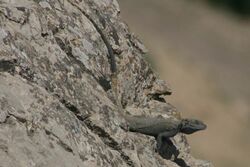Biology:Laudakia nupta
| Laudakia nupta | |
|---|---|

| |
| Scientific classification | |
| Domain: | Eukaryota |
| Kingdom: | Animalia |
| Phylum: | Chordata |
| Class: | Reptilia |
| Order: | Squamata |
| Suborder: | Iguania |
| Family: | Agamidae |
| Genus: | Laudakia |
| Species: | L. nupta
|
| Binomial name | |
| Laudakia nupta (De Filippi, 1843)
| |
| Synonyms[2] | |
|
Laudakia nupta nupta
Laudakia nupta fusca:
| |
Laudakia nupta is a species of lizard from Iraq, Iran, Afghanistan, and Pakistan. It was described in 1843. There are two subspecies, Laudakia nupta nupta and Laudakia nupta fusca.
Taxonomy
L. nupta was described by Filippo De Filippi in 1843. Its taxonomy has been moved many times, having previously been classified under the genera Agama and Stellio.[2] The current scientific name comes from the past participle of the Latin verb nūbo, meaning to cover or veil. The meaning shifted over time, coming to mean a bride that covers herself for the groom.[2] The bride's crown is a reference to the lizard's crown-like crest.[2]
Laudakia nupta nupta is commonly known as large-scaled agama or large-scaled rock agama,[2][3] and Laudakia nupta fusca is commonly known as yellow-headed rock agama.[2][4]
Description
L. nupta is a large sized lizard with a heavy head and nostrils on the canthus rostralis. The body is moderately depressed, and there are vertebral enlarged scales covering most of the lizard's back. It has a long tail with segments of three whorls. L. nupta has oviparous reproduction.[2]
The subspecies L. nupta nupta is yellowish or reddish brown, and the vertebral enlarged scales are strongly keeled.[2]
The subspecies L. nupta fusca has no nuchal fold, and the vertebral enlarged scales are strongly mucronate.[2]
Diet
Plants are the main source of food for L. nupta.[5] L. nupta fusca is omnivorous and are known to consume Daphne oleoides, beetles, and ants.[6]
Habitat and distribution
L. nupta is typically found in western Asia. The subspecies L. nupta nupta can be found in eastern Iraq, Iran, Afghanistan, and Pakistan.[2] It resides in large limestone rocks and outcrops with deep crevices, and in man-made structures like mud-brick homes and old buildings.[7] The subspecies L. nupta fusca can be found in southern Pakistan and southern Iran.[2]
References
- ↑ Anderson, S.; Papenfuss, T. (2021). "Laudakia nupta". IUCN Red List of Threatened Species 2021: e.T164692A1068143. doi:10.2305/IUCN.UK.2021-3.RLTS.T164692A1068143.en. https://www.iucnredlist.org/species/164692/1068143. Retrieved 18 April 2022.
- ↑ 2.00 2.01 2.02 2.03 2.04 2.05 2.06 2.07 2.08 2.09 2.10 Laudakia nupta at the Reptarium.cz Reptile Database. Accessed 2021-01-01.
- ↑ ITIS
- ↑ "ADW: Laudakia nupta: CLASSIFICATION". https://animaldiversity.org/accounts/Laudakia_nupta/classification/.
- ↑ Sanchooli, Naser (2017-05-01). "Habitat suitability and potential distribution of Laudakia nupta (De Filippi, 1843) (Sauria: Agamidae) in Iran" (in en). Russian Journal of Ecology 48 (3): 275–279. doi:10.1134/S106741361703016X. https://doi.org/10.1134/S106741361703016X.
- ↑ Qashqaei, Ali Turk; Ahmadzadeh, Faraham (2015-08-04). "Dietary records of yellow-headed agama in Hormozgan Province, Iran" (in en). Russian Journal of Herpetology 22 (4): 315–317. doi:10.30906/1026-2296-2015-22-4-315-317. http://rjh.folium.ru/index.php/rjh/article/view/967.
- ↑ Rahimian, Hassan; Pazoki, Samaneh; Habashi, Sima Abbasi (2014-08-13). "Gastrointestinal nematodes of Laudakia nupta nupta (Sauria: Agamidae) from Iran with descriptions of two new species (Oxyuridea: Pharyngodonidae) and comments on the diagnostic features of Parapharyngodon and Thelandros" (in en). Zootaxa 3852 (1): 51–82. doi:10.11646/zootaxa.3852.1.2. https://www.biotaxa.org/Zootaxa/article/view/zootaxa.3852.1.2.
External links
Wikidata ☰ Q3218582 entry
 |


